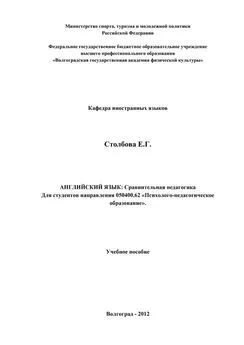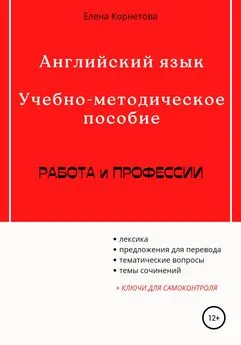Елена Беликова - Английский язык для медиков: конспект лекций
- Название:Английский язык для медиков: конспект лекций
- Автор:
- Жанр:
- Издательство:Конспекты, шпаргалки, учебники «ЭКСМО»b4455b31-6e46-102c-b0cc-edc40df1930e
- Год:2007
- Город:Москва
- ISBN:978-5-699-20181-5
- Рейтинг:
- Избранное:Добавить в избранное
-
Отзывы:
-
Ваша оценка:
Елена Беликова - Английский язык для медиков: конспект лекций краткое содержание
Представленный вашему вниманию конспект лекций предназначен для подготовки студентов медицинских вузов к сдаче экзамена. Книга включает в себя полный курс лекций по английскому языку, написана доступным языком и будет незаменимым помощником для тех, кто желает быстро подготовиться к экзамену и успешно его сдать.
Английский язык для медиков: конспект лекций - читать онлайн бесплатно ознакомительный отрывок
Интервал:
Закладка:
liquid – жидкость
proximity – близость
adjacent – смежный
large – большой
intermolecular – межмолекулярный
to stabilize – стабилизироваться
surface – поверхность
to produce – производить
side – сторона
weak – слабый
greater – больше
distance – расстояние
between – между
phase – фаза
tension – напряженность
spherically-curved – сферически-кривой
lining – выравнивание
inward – внутрь
toward – к
curvature – искривление
spherical – сферический
similar – подобный
soap – мыло
inner – внутренний
to exert – проявить
interconnected – связанный
something – что-нибудь, что-то
everything – все
Употребление something, anything, nothing или everything
1. Утвердительная форма:
I can see something on the table.
2. Отрицательная форма:
I can see nothing on the table. I cannot see any thing on the table.
3. Вопросительная форма:
Can you see anything on the table?
Вставьте something, anything, nothing или everything.
1… is all right, the patient is much better today.
2. Is there… interesting in the programme of the concert?
3. I could see…: it was quite dark.
4. Give me… to drink.
5. I didn't take any money with me, so I couldn't buy…
6. My new eyeglasses are very good, I can see… now.
7. I saw… near the wood that looked like a tent.
8. Give me… to read, please.
9. I don't know… about your town. Tell me… about it.
10. Please give me… warm: it is cold here.
11. I understand… now. Thank you for your explanation.
12. There is… white in the box. What is it?
13. Is there… that you want to tell me?
14. Where is the book? – It is on the table. – No, there is… there.
15. I know. about it.
16. Tell me. about your family.
Answer the questions.
1. What forces serve to stabilize the liquid?
2. What does the liquid air produces?
3. Where are the liquid – air forces strong and weak?
4. Why are the liquid – air forces strong and weak?
5. What does the surface tension cause?
6. Where the liquid lining layer tend to be pulled?
7. In what manner does the spherical surface of the alveolar liquid lining behave?
8. What creates a greater pressure inside than outside the bubble?
9. Where interconnected alveoli of different sizes could lead?
10. What is a pulmonary surfactant?
Make the sentences of your own using the new words (10 sentences).
Make your own sentences using something, anything, nothing everything (10 sentences).
Find one word, which is a little bit different in meaning from others (найдите одно слово, которое немного отличается от других по смыслу):
1) a) eyelashes; b) lips; c) eyelid;
2) a) skull; b) head; c) heart;
3) a) esophagus; b) vein; c) intestines;
4) a) knee; b) blood; c) vein;
5) a) capillaries; b) arteries; c) bones.
ЛЕКЦИЯ № 29. The nose
The respiratory system permits the exchange of oxygen and carbon dioxide between air and blood by providing a thin cellular membrane deep in the lung that separates capillary blood from alveolar air. The system is divided into a conduct ing portion (nasal cavity, pharynx, larynx, trachea, bronchi, bronchioles) that carries the gases during inspiration and expiration, and a respiratory portion (alveoli) that provides for gas exchange between air and blood.
The nose contains the paired nasal cavities separated by the nasal septum. Anteriorly, each cavity opens to the outside at a nostril (naris), and posteriorly, each cavity opens into the nasopharynx. Each cavity contains a vestibule, a respiratory area, and an olfactory area, and each cavity communicates with the paranasal sinuses.
Vestibule is located behind the nares and is continuous with the skin.
Epithelium is composed of stratified squamous cells that are similar to the contiguous skin.
Hairs and glands that extend into the underlying connective tissue constitute the first barrier to foreign particles entering the respiratory tract.
Posteriorly, the vestibular epithelium becomes pseudostratified, ciliated, and columnar with goblet cells (respiratory epithelium).
Respiratory area is the major portion of the nasal cavity.
Mucosa is composed of a pseudostratified, ciliated, columnar epithelium with numerous goblet cells and a subjacent fibrous lamina propria that contains mixed mucous and serous glands.
Mucus produced by the goblet cells and the glands is carried toward the pharynx by ciliary motion.
The lateral wall of each nasal cavity contains three bony pro jections, the conchae, which increase the surface area and pro mote warming of the inspired air. This region is richly vascularized and innervated.
Olfactory area is located superiorly and posteriorly in each of the nasal cavities.
The pseudostratified epithelium is composed of bipolar neu rons (olfactory cells), supporting cells, brush cells, and basalcells. The receptor portions of the bipolar neurons are modi fied dendrites with long, nonmotile cilia.
Under the epithelium, Bowman's glands produce serous fluid, which dissolves odorous substances.
Paranasal sinuses are cavities in the frontal, maxillary, ethmoid and sphenoid bones' that communicate with the nasal cavities.
The respiratory epithelium is similar to that of the nasal cavi ties except that it is thinner.
Numerous goblet cells produce mucus, which drains to the nasal passages. Few glands are found in the thin lamina propria.
New words
respiratory system – дыхательный аппарат
exchange – обмен
oxygen – кислород
carbon – углерод
dioxide – диоксид
cellular – клеточный
membrane – мембрана
deep – глубоко
capillary – капилляр
conduct ing – проведение
portion – часть
nasal cavity – носовая впадина
pharynx – зев
larynx – гортань
trachea – трахея
bronchi – бронхи
bronchioles – бронхиолы
inspiration – вдохновение
expiration – истечение
the paired – соединенный
nasal septum – носовая перегородка
anteriorly – раньше
nostril – ноздря
posteriorly – сзади
vestibule – вестибулярный
respiratory area – дыхательная область
olfactory area – обонятельная область
paranasal sinuses – параназальные пазухи
somebody – кто-нибудь, кто-то
Употребление somebody, anybody, nobody или everybody.
1. Утвердительная форма:
Не asked somebody to help him.
2. Отрицательная форма:
He asked nobody to help him. He did not ask any body to help him.
3. Вопросительная форма:
Did he ask anybody to help him?
Вставьте somebody, anybody, nobody или everybody.
1. Has… in this group got a dictionary?
2… left a magazine in our classroom yesterday.
3. The question was so difficult that… could answer it.
4. I am afraid I shan't be able to find… in the office now: it is too late.
5… knows that water is necessary for life.
6. Is there… here who knows French?
7. You must find… who can help you.
8… knew anything about America before Colum bus discovered it.
9. I saw… in the train yesterday who looked like you.
10. There is… in the next room. I don't know him.
11. Please tell us the sto ry… knows it.
12. Is there… in my group who lives in the dormitory?
13. Has… here got a red pencil?
14… can answer this question. It is very easy.
15. We haven't… black stockings.
16. They have… red boots, Kate.
17. I don't want… today
18. I haven't got… clean exercise-books. 19 We shall not buy… in this shx^
20. Didn't you buy… potatoes yesterday?
Answer the questions.
1. What does the respiratory system permit?
2. The exchange of what does the respiratory system permit?
3. What does the respiratory system provide deep in the lung?
4. What does separate capillary blood from alveolar air?
5. How is the respiratory system divided?
6. What does the nose contain?
7. What does each nasal cavity contain?
8. Where does each nasal cavity open to?
9. Where is vestibule located?
10. What is the major portion of the nasal cavity?
Make the sentences of your own using the new words (10 sentences).
Make the sentences of your own using somebody, anybody, nobody или everybody(10 sentences).
Find one word, which is a little bit different in meaning from others (найдите одно слово, которое немного отличается от других по смыслу):
1) a) digestion; b) nose; c) air;
2) a) cavity; b) nose; c) organ;
3) a) breath; b) nasal cavity; c) cartilage;
4) a) mouth; b) lip; c) ear;
5) a) oxygen; b) carbon; c) hydrogen.
ЛЕКЦИЯ № 30. Nasopharynx and larynx
Nasopharynx is the first part of the pharynx.
It is lined by a pseudostratified, ciliated, columnar.
Epithelium with goblet cells: under the epithelium, a gland-containing connective tissue layer rests directly on the periosteum of the bone.
The cilia beat towards the oropharynx, which is composed of a stratified, squamous, nonkeratinized epithelium.
The pharyngeal tonsil, an aggregate of nodular and diffuse lymphatic tissue, is located on the posterior wall of the nasopharynx subjacent to the epithelium. Hypertrophy of this tissue as a result of chronic inflammation results in a condition known as adenoiditis. Larynx is a passageway that connects the pharynx to the trachea and contains the voicebox. Its walls are composed of cartilage held together by fibroela-stic connective tissue.
The mucous layer of the larynx forms two pairs of elastic tissue folds that extend into the lumen. The upper pair are called the vestibu-lar folds (or false vocal cords), and the lower pair con stitute the true vocal cords. The epithelium of the ventral side of the epiglottis and of the vocal cords is composed of stratified, squamous, nonkeratinized cells. The remainder of the larynx is lined with ciliated, pseudostrati-fied, columnar epithelium. All cilia, from the larynx to the lungs, beat upward toward the nasopharynx.
New words
nasopharynx – носоглотка first – сначала
pseudostratified – псевдомногослойный
ciliated – снабженный ресничками
columnar – колоночный
epithelium – эпителий
goblet cells – кубические клетки
gland-containing – содержащий железу
Читать дальшеИнтервал:
Закладка:










